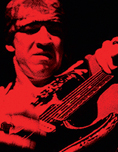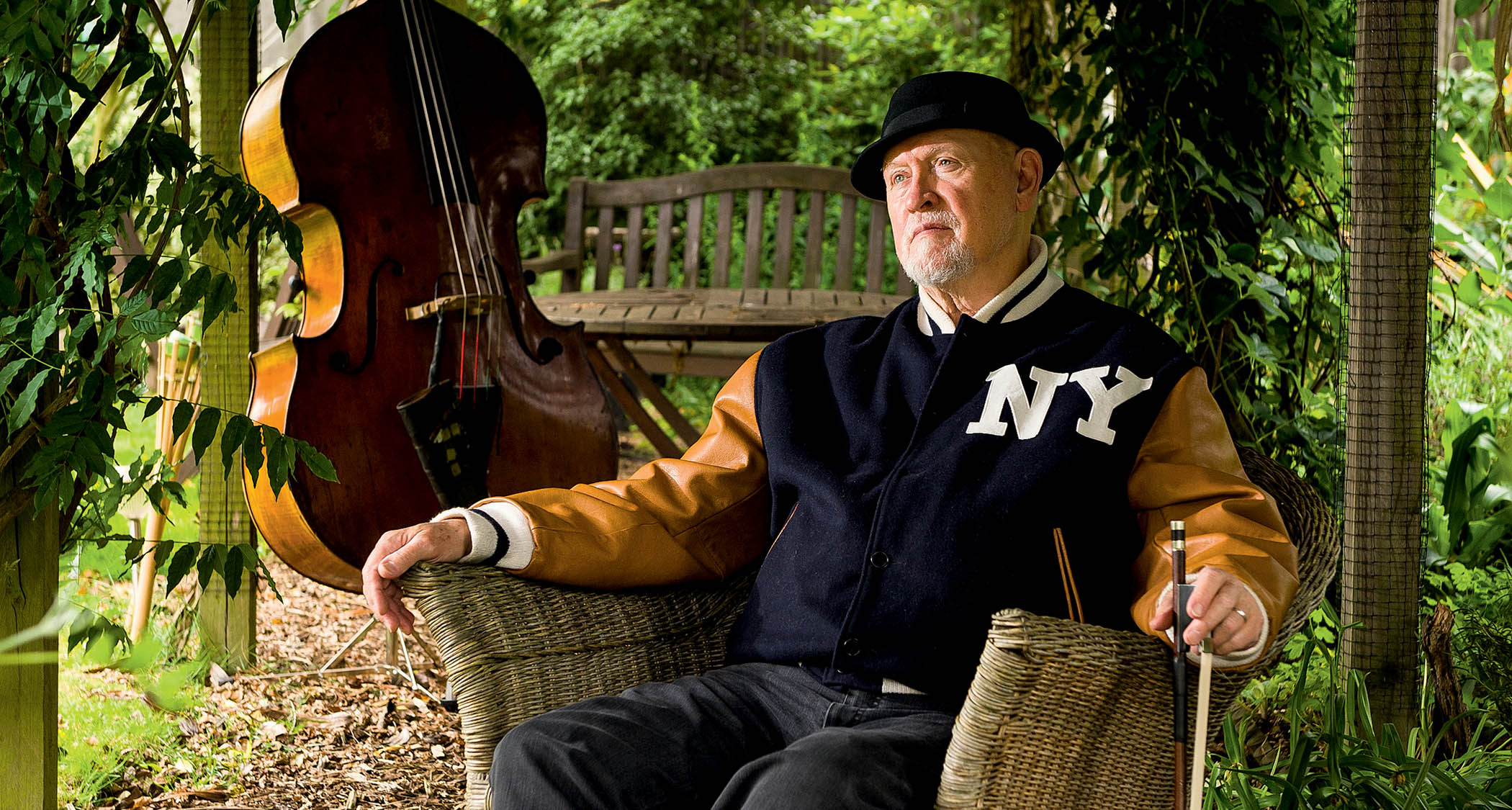Stevie Ray Vaughan: Soul to Soul

Andy Aledort reveals the secrets behind the powerfully passionate guitar work of blues great Stevie Ray Vaughan.
Stevie Ray Vaughan's arrival on the music scene in 1983 came by way of his powerful and passionate guitar playing on David Bowie’s Let’s Dance album and the simultaneous release of Vaughan’s debut masterpiece, Texas Flood. In what seemed like an instant, he became one of the most important guitarists of the day, one who, single-handedly it seemed, reinvigorated the blues scene with his soulful and distinctive chops. Today, more that 16 years since the tragic helicopter accident that took his life, Vaughan’s expressive and muscular guitar style has proven more influential and vital than ever. In this lesson, we’ll identify the signature elements of his rhythm and lead playing, and show you how to sound like Stevie.
Vaughan always tuned his guitar down one half step (low to high: Eb Ab Db Gb Bb Eb), a tuning popularized by Jimi Hendrix and Eddie Van Halen. Guitarists who use this tuning generally refer to chords, scales and riffs as if their guitar were tuned normally. For instance, even though an E chord will actually sound Eb in this tuning, it will be referred to as an E chord.
One of Vaughan’s most well-known and best-loved tunes is the hard-driving Texas shuffle “Pride and Joy,” originally recorded for Texas Flood. On this track, the guitarist demonstrates his masterful assimilation of the rhythm and accompaniment styles of such blues guitar greats as Jimmy Reed, Lightnin’ Hopkins, Clarence “Gatemouth” Brown and Freddie King.
FIGURE 1 represents the first eight bars of a standard 12-bar blues progression in E, played in a manner reminiscent of Vaughan’s rhythm part on “Pride and Joy.” During most of the progression, the rhythm part consists primarily of upstrokes on the top three strings, sounded on the eighth-note upbeats—(one) and (two) and (three) and (four) and—with little licks based on the E minor pentatonic scale (E G A B D) thrown in here and there. All of these upbeat accents should be strummed with upstrokes and picked very aggressively to emulate the intensity with which Vaughan attacked the song.
When playing the rhythm guitar on “Pride and Joy,” Vaughan inserts a variety of different turnaround licks at the end of each 12-bar progression, so called because these licks serve to wrap up the end of one 12-bar cycle and set up the next. There are a great many different ways to play a classic blues turnaround; FIGURES 1a–d show four turnaround licks representative of Vaughan’s style.
In FIGURE 1a, we begin from the five chord, B7, which is performed with hybrid picking (a combination of fingerpicking and flatpicking), as well as a “thumbed” low F# added to the chord. Wrap the left hand’s thumb around the top side of the neck to fret the sixth string at the second fret. In bars 2 and 3 of the figure, a lick based on E minor pentatonic and incorporating a combination of open strings, pull-offs and slides is played across the A(7) and E(7) chords. In bar 2, the three notes on the upbeat of beat three should be played using a reverse rake: drag the pick across the top three strings, starting with the first string, in a continual upstroke. Follow this with a slide from the fourth fret down to the second on the G string, ending with a pull-off to the open G note.
All the latest guitar news, interviews, lessons, reviews, deals and more, direct to your inbox!
FIGURE 1b begins with a “walk up” to B7, which is then articulated similarly to the B7 chord in FIGURE 1a. This is followed with root-fifth, root-sixth chord movements over A, and the turnaround lick falls in the last two bars of the example. Again, notice how open strings are used in conjunction with hammer-ons, pull-offs and slides. A twist here is the inclusion of the chromatically descending chord movement from C9 to B9 at the end of the turnaround.
The first two bars of FIGURE 1c are similar to those of the previous two examples. For the turnaround in the last two bars, notice the subtle use of half-step bends on both the high E and low E strings.
FIGURE 1d begins with a similar B7 figure but is followed in the second bar with a more complex hybrid-picking lick, wherein a melody note on the high E string is played against an A root note on the G string. A few new variations are thrown in over the last two bars, so study these turnaround licks carefully and then compare them to each other.
One of the most impressive aspects of Vaughan’s playing was his virtuosity as a soloist. He forged his distinct style from a blend of blues, rock and roll, blues rock and jazz influences. When playing over a song like “Pride and Joy,” which is a 12-bar blues shuffle in the key of E, Vaughan got a lot of mileage out of the 12th-position E minor pentatonic scale “box” pattern. He often built his improvised lines from a variety of repeated three-note figures played in the rhythm of eighth-note triplets. FIGURE 2a illustrates three three-note licks that Vaughan often played. In FIGURE 2b, the licks are combined in a handful of ways reminiscent of what the guitarist played in his “Pride and Joy” solo.
A great way to follow up a sequence of phrases based on a rhythm of eighth-note triplets is to move into different kinds if rhythms and melodic phrases, as demonstrated in FIGURE 2c. Following a bar of steady eighthnote triplets, bar 2 begins with a slow bend held across beats one and two, after which dotted quarter notes are balanced against more eighth-note-triplet phrases.
Another signature element of Vaughan’s soloing style is the way he would dramatically incorporate huge, lightning-fast position shifts into the middle of a long sequence of notes. FIGURE 2d starts with two two-bar phrases that begin in 12th position and then quickly shift down to first position via an aggressive slide down the G string. A great way to follow this type of position shift is to improvise openposition licks using the E minor blues scale (E G A Bb B D) and open strings, as demonstrated in the third and fourth phrases of FIGURE 2d.
Another key element of Vaughan’s guitar style is very aggressive picking; to emulate the guitarist’s trademark “throaty” sound, try to get a little bit of the edge of the thumb into your pick attack and pick close to the end of the fretboard, or even over it.
One of the most prominent influences on Vaughan’s soloing was the intense, powerful style of blues great Albert King, identified by a sharp, fingerpicked attack and expressive, perfectly intonated bends, many of them beyond the range of a whole step. King’s influence can be detected on a great many SRV tunes, but perfect examples within the context of a slow blues are “Texas Flood” and “Ain’t Gon’ Give Up on Love.”
FIGURE 3a shows a classic Albert King–style lick played over a slow 12/8 blues. To articulate this lick correctly in a King/Vaughan style, fingerpick all notes on the high E string with the middle or ring finger, pulling the string up as you pick it so that it snaps against the fretboard and creates a sharp, stinging sound.
FIGURE 3b depicts a more elaborate version of a similar lick: in bar 1, notice that the opening phrase begins on a different beat, and at the end of bar 1 into bar 2, the phrase is articulated with a procession of wholeand half-step bends at the sixth, seventh and eighth frets. In bars 3 and 4, the soloing shits from sixth to third position via the lick on beat one of bar 3—an SRV trademark—and wraps up in bar 4 with a slick, bass-register phrase.
When King would play a lick like the one shown in FIGURE 3c, he would play all of the bends on the high E string. The guitarist was able to do this without an inordinate amount of effort, because he tuned his guitar down one and a half steps, which makes the strings much easier to bend. If one’s strings were tuned normally, or even down one half step as Vaughan’s were, the high E would likely break if it were repeatedly bent two whole steps, as shown in bar 3 of FIGURE 3c. A good way to emulate King’s style while reducing the risk of breaking a string is to move the lick over to the B string, as shown in bar 4. Vaughan, however, would alter the lick in the way shown in bars 5–7, moving between sixth and third positions.
Part of the greatness of Vaughan’s musicianship was that he was able to appropriate a great many of King’s licks and incorporate them beautifully into his own style; FIGURE 3d illustrates an example of this type of playing.
One of my favorite “Albert-isms” that Stevie made great use of is the lick shown in FIGURE 3e. Here, nearly identical melodic lines articulated with bends are played octaves apart, as the series of bends are executed on either the G or high E string.
FIGURE 4 presents what many people refer to as the “Stevie” lick: following the first two eighth-note-triplet phrases, a G note at the third fret on the high E is followed by a hammer-on up to Af on the fourth fret, and a pull-off back to the third fret G. This lick was popularized by the great blues guitarist T-Bone Walker and was later utilized by Jimi Hendrix. Vaughan took the lick and refined it into a wide variety of creative and expressive blues phrases.
When playing all of the examples in this lesson, strive for absolute clarity in the execution of every note and perfect intonation with every bend. Stevie wouldn’t have it any other way.
